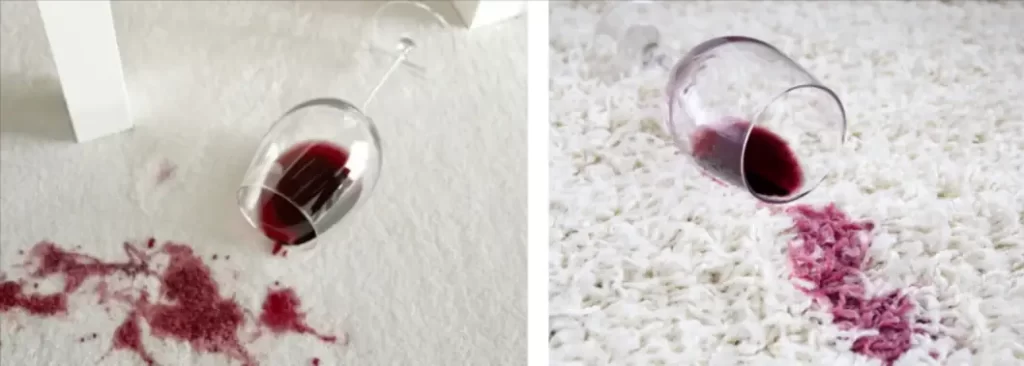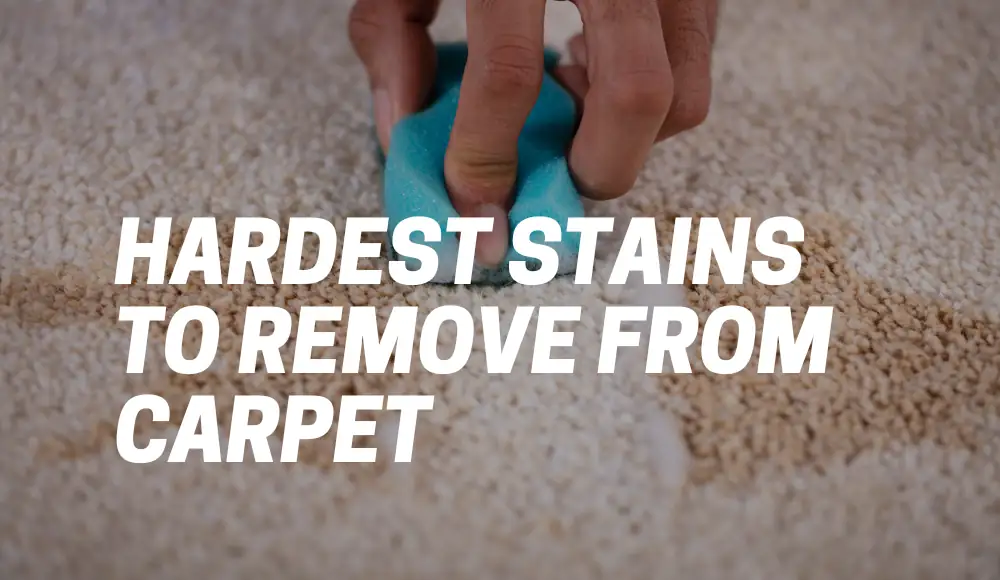Carpet stains can be a nightmare to deal with. Whether it’s a spill, a pet accident, or a mishap during a party, those stubborn marks on your carpet can be quite a headache. You may find yourself wondering, “Are there stains that cannot be removed from carpet?”.
Well, let’s dive into the world of carpet stains and find out.
Are There Stains That Cannot Be Removed From Carpet?
When it comes to carpet stains, most can be effectively removed with the right techniques and cleaning products.
However, there are certain stains that pose more significant challenges and may prove difficult to eliminate entirely.
Red wine
One example of a stubborn carpet stain is red wine. We’ve all been there – accidentally knocking over a glass of red wine during a celebration, only to watch in horror as it seeps into the fibers of your beautiful carpet.

Red wine contains pigments that can deeply penetrate the carpet, making it tough to remove completely. While there are remedies and cleaners available, it’s crucial to act quickly to prevent the stain from setting.
Ink
Another notorious culprit is ink.
Ink stains can be caused by a leaky pen or an accidental spill while you’re working on a project. Ink contains dyes that can be particularly challenging to remove from carpet fibers.
Immediate action and the right cleaning methods are key to successfully tackling ink stains.
What Are the Hardest Stains to Remove From Carpet?
When it comes to the hardest stains to remove from carpet, there are a few more culprits that can give you a tough time.
Let’s take a look at some of them:
- Coffee Stains: Coffee spills are a common occurrence in many households, and they can leave behind noticeable stains on your carpet. The dark color and tannins present in coffee can make it challenging to remove completely. Immediate blotting and using a mixture of mild dish soap and water can help tackle coffee stains effectively.
- Blood Stains: Accidents happen, and unfortunately, blood stains can be particularly stubborn to remove from carpet fibers. Blood contains proteins that can bind tightly to the fibers, making it harder to eliminate. It’s important to address blood stains promptly by blotting gently with cold water and using an enzyme-based cleaner designed specifically for blood stains.
- Oil and Grease Stains: Whether it’s from cooking mishaps or a dropped greasy snack, oil, and grease stains can be a real headache. These stains can quickly penetrate the carpet fibers and leave behind unsightly marks. Immediate action is crucial to prevent the stain from setting. Start by blotting the excess grease with a clean cloth, then use a specialized carpet cleaner or a mixture of dish soap and warm water to treat the stain. Remember to blot gently and avoid rubbing, as it can spread the stain further.
- Permanent Marker Stains: Accidentally getting permanent markers on your carpet can be distressing. As the name suggests, permanent markers contain highly pigmented and long-lasting ink. Removing permanent marker stains requires a multi-step approach. Start by blotting the stain gently with a cloth soaked in rubbing alcohol. Keep blotting until the marker ink transfers onto the cloth. Then, rinse the area with water and blot dry. Repeat the process as necessary.
- Pet Vomit Stains: Dealing with pet vomit stains can be unpleasant, but they can also be challenging to remove. Pet vomit contains a combination of food particles, digestive enzymes, and stomach acids that can cause discoloration and leave behind stubborn stains. Begin by removing any solid matter carefully, then blotting the area with a mixture of water and mild dish soap. For stubborn stains and odors, consider using an enzyme-based cleaner specifically formulated for pet messes.
It’s worth noting that the success of stain removal depends on various factors, including the type of stain, carpet material, and the promptness of your actions.
When tackling tough stains, it’s essential to be patient, use appropriate cleaning methods, and test any cleaning solution in a small, inconspicuous area of your carpet before applying it to the stain.
By being proactive and following the right techniques, you can increase your chances of successfully removing even the most challenging stains from your carpet.
Oil-Based Stains: The Most Stubborn Carpet Stains
When it comes to carpet stains, oil-based stains are often the most challenging to remove.
These types of stains come from substances like grease and motor oil, which can be extremely stubborn when they penetrate carpet fibers.
Oil-based stains are notorious for leaving behind a residue that attracts dirt and debris, making them even harder to get rid of.
Grease Stains
One of the most common oil-based stains found in carpets is grease. Grease stains often occur in areas where food is prepared or near machinery that produces greasy substances.
These types of spills can easily soak into carpet fibers and leave behind an oily residue that can attract more dirt over time.
Motor Oil Stains: A Nightmare for Homeowners
Another type of oil-based stain that can be particularly difficult to remove from carpets is motor oil. This type of spill can quickly saturate the carpet fibers and leave behind a dark, unsightly stain that seems impossible to get out.
Unfortunately, traditional cleaning methods like soap and water won’t cut it when it comes to removing motor oil from carpets.
Rust Stains: The Stubborn Carpet Stain
Rust stains are one of the toughest stains to remove from carpet. These stains occur when metal objects that are left on the carpet begin to rust, leaving behind a reddish-brown stain.
Rust stains can occur from a variety of sources, such as old furniture with metal legs, or from metal items accidentally left on the carpet for too long.
The Challenge of Removing Rust Stains
One reason rust is particularly hard to remove is that it is an oxidized compound that can bond with the fibers of your carpet.
Removing rust requires breaking down this bond between the stain and the fibers of your carpet to lift and extract it.
Additionally, rust has a high level of acidity which means that it can cause damage to some natural fibers in your carpet if left untreated for too long. This makes treating rust stains quickly even more important.
How To Remove Rust Stains From Carpet
—
Removing Rust Stains from Carpet
To remove rust stains from your carpet, you need specialized cleaning solutions designed specifically for removing this tough-to-treat type of stain. One method involves using white vinegar and salt paste which can help break down and lift out the stain.
Another solution involves treating with lemon juice or hydrogen peroxide combined with baking soda – these options offer more powerful cleaning options but should be used with caution as they may damage or discolor certain types of carpets. If all else fails or if you’re worried about damaging your carpets while trying to treat stubborn rust stains, consider calling in professional cleaners who have experience dealing with these types of challenging spills.
What Will Permanently Stain Carpet?
Certain substances have properties that make them more likely to leave behind permanent stains on your carpet.
Understanding these substances can help you take preventative measures and protect your carpet from irreparable damage.
Bleach
Bleach is one such substance that can cause permanent discoloration. It is a powerful cleaning agent commonly used for disinfection and stain removal. However, if accidentally spilled or used incorrectly, bleach can bleach your carpet fibers and leave behind unsightly spots.
Pet urine
Another notorious culprit is pet urine. Urine contains uric acid, which can cause color changes and permanent damage to carpet fibers. If left untreated, the odor and stains from pet urine can become a recurring problem. It’s important to address pet accidents promptly and use specialized cleaners to neutralize the odor and remove the stains effectively.
How to Remove Stains in Carpet That Keep Coming Back
Dealing with stains that keep reappearing on your carpet can be incredibly frustrating.
You clean the stain, and think it’s gone for good, but then it magically resurfaces. There are a few reasons why this may happen, but the most common cause is residue.
Residue can occur when the cleaning solution used to treat the stain is not properly rinsed out or removed from the carpet fibers. The remaining residue can attract dirt and grime, causing the stain to reappear over time.
To tackle stains that keep coming back, follow these steps:
- Blot the stain: Begin by blotting the stain gently with a clean cloth or paper towel. Avoid rubbing, as it can spread the stain further.
- Apply a cleaning solution: Choose a carpet cleaner specifically designed for the type of stain you’re dealing with. Follow the instructions on the product and apply it to the stained area.
- Blot and rinse: After allowing the cleaning solution to sit for a few minutes, blot the area again to remove the stain and cleaner. Then, rinse the area thoroughly with clean water and blot dry.
- Use a vinegar solution: If the stain persists, you can try using a mixture of vinegar and water. Mix equal parts white vinegar and water, apply it to the stain, and blot gently. Vinegar can help neutralize odors and remove stubborn stains.
- Professional cleaning: If all else fails, it may be time to call in the professionals. Professional carpet cleaners have the expertise and specialized equipment to tackle even the toughest stains.
Useful Information: Carpet Stain Removal Guide
To help you navigate the world of carpet stain removal, here’s a handy guide outlining the steps to tackle common stains:
- Red Wine Stains:
- Blot the stain immediately with a clean cloth.
- Mix a solution of equal parts dish soap and hydrogen peroxide.
- Apply the solution to the stain and blot gently.
- Rinse with clean water and blot dry.
- Ink Stains:
- Blot the stain with a clean cloth.
- Apply rubbing alcohol to a clean cloth and dab the stain gently.
- Rinse with clean water and blot dry.
- Bleach Stains:
- Unfortunately, bleach stains are often permanent.
- In severe cases, you may need to consider patching or replacing the affected carpet.
- Pet Urine Stains:
- Blot the stain with a clean cloth.
- Use a pet stain remover specifically designed for urine stains.
- Follow the instructions on the product and thoroughly rinse the area.
Remember, always test any cleaning solution or method in an inconspicuous area of the carpet before applying it to the stain to ensure it doesn’t cause discoloration or damage.
FAQs
How to remove old stains from carpet with vinegar?
To remove old stains from carpet using vinegar, create a mixture of equal parts white vinegar and water. Apply the vinegar solution to the stain and let it sit for a few minutes. Blot the area gently with a clean cloth until the stain lifts. Rinse with clean water and blot dry.
How to remove grease from carpet?
Grease stains on carpet can be challenging to remove. Begin by blotting the stain with a clean cloth to absorb as much grease as possible. Sprinkle baking soda or cornstarch over the stain and let it sit for about 15 minutes to absorb the grease. Vacuum the area to remove the powder, then treat the remaining stain with a grease-fighting dish soap and warm water solution. Blot gently and rinse thoroughly.
Conclusion
While some carpet stains can be difficult to remove, there are effective methods and cleaning solutions available to tackle even the toughest marks.
Acting quickly, using the right techniques, and taking preventative measures can go a long way in keeping your carpets clean and stain-free.
Remember to test any cleaning solution in an inconspicuous area and, when in doubt, seek professional help. With a little patience and perseverance, you can restore the beauty of your carpet and say goodbye to those pesky stains.


